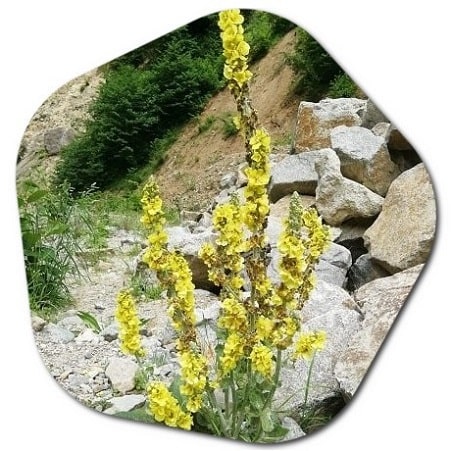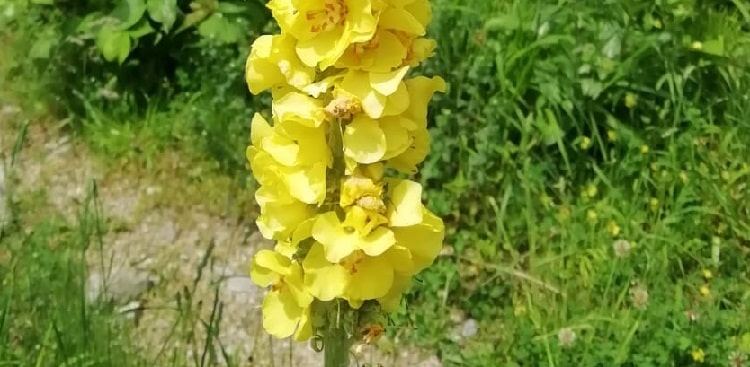Of course, this flowering plant species can grow in America. Verbascum thapsus, commonly known as mullein, can grow in America. In fact, it is a native plant to Europe, Asia, and North Africa but has naturalized in various regions of the United States and Canada. Mullein is known for its adaptability to different soil types and climates, and it can be found growing in fields, meadows, disturbed areas, and along roadsides throughout many parts of North America.
Mullein is a biennial plant that produces a tall flowering stalk, reaching heights of 2 to 8 feet (0.6 to 2.4 meters). The leaves are large, soft, and fuzzy, and the plant produces yellow flowers on the stalk in its second year of growth. The flowers are densely packed on a spike and are known to attract various pollinators.

As an herbal plant, mullein has a long history of use in traditional medicine. Its leaves and flowers are often used to make herbal teas, tinctures, or infused oils, which are believed to have soothing and expectorant properties, making them useful for respiratory issues such as coughs and congestion.
However, it’s worth noting that while mullein is not considered invasive, it can self-seed and spread under certain conditions. If you’re planning to grow Verbascum thapsus in your garden, it’s a good idea to ensure it doesn’t escape and cause unintended ecological consequences in natural areas.
Where does Verbascum thapsus grow in the USA?
Verbascum thapsus, or mullein, can be found growing in various regions of the United States. It has naturalized and established populations in many states across the country. Here are some areas where Verbascum thapsus commonly grows:
- Northeastern United States: Mullein can be found in states such as Maine, New Hampshire, Vermont, Massachusetts, Connecticut, Rhode Island, New York, New Jersey, Pennsylvania, and Maryland.
- Midwestern United States: It is present in states like Michigan, Ohio, Indiana, Illinois, Wisconsin, Minnesota, Iowa, Missouri, and Kansas.
- Southeastern United States: Mullein can be found in parts of Kentucky, Tennessee, Virginia, North Carolina, South Carolina, Georgia, Alabama, Mississippi, and Florida.
- Southwestern United States: It grows in regions of Texas, New Mexico, Arizona, and southern California.
- Western United States: Mullein can be found in states like Washington, Oregon, Idaho, Montana, Wyoming, Nevada, Utah, Colorado, and parts of California.
It’s important to note that the distribution of Verbascum thapsus can vary within each state, and it may not be found in every county or region. The plant tends to prefer open, sunny areas with well-drained soils and can often be seen growing in fields, meadows, pastures, roadsides, and disturbed areas.
Is Verbascum thapsus growing in America good for health?
Verbascum thapsus, or mullein, has a history of traditional use in herbal medicine for various health purposes. While some people believe in its potential health benefits, it’s important to note that the scientific evidence supporting these claims is limited and more research is needed. Here are some commonly attributed uses of Verbascum thapsus:
- Respiratory Health: Mullein is often used to alleviate respiratory issues such as coughs, bronchitis, and congestion. It is believed to have soothing and expectorant properties that may help to relieve cough symptoms. Mullein leaves and flowers are commonly used to make herbal teas or tinctures for this purpose.
- Anti-inflammatory and Analgesic Properties: Some proponents of mullein suggest that it may have anti-inflammatory and analgesic effects. It is sometimes used topically as an oil or salve to help with skin irritations, wounds, or joint pain. However, scientific studies supporting these claims are limited.
- Ear Health: Mullein oil is sometimes used in herbal ear drops to address earaches and ear infections. However, it’s important to consult with a healthcare professional before using any alternative remedies for ear issues.
It’s worth noting that herbal remedies can vary in effectiveness and may have potential side effects or interactions with medications. It is always advisable to consult with a qualified healthcare professional or herbalist before using any herbal product, including Verbascum thapsus, for medicinal purposes. They can provide personalized guidance based on your specific health condition and medical history.
When does Verbascum thapsus bloom?
Verbascum thapsus, or mullein, typically blooms in the summer months. The exact timing of its blooming can vary depending on the specific geographic location and climate conditions. In general, mullein begins to flower in late spring or early summer and continues blooming into mid to late summer.

The flowering period of mullein can span several weeks to a couple of months. During this time, the plant produces tall flowering stalks that can reach heights of 2 to 8 feet (0.6 to 2.4 meters). The flowers are typically yellow and densely packed on a spike. The individual flowers open from the bottom of the spike upward, resulting in a gradual progression of blooming. What are mullein flowers and leaves like? >>
It’s important to note that mullein is a biennial plant, meaning it completes its life cycle in two years. In the first year, it forms a basal rosette of large, fuzzy leaves close to the ground. The second year is when the plant sends up its characteristic flowering stalk and produces flowers.
Keep in mind that weather conditions, regional variations, and local growing conditions can influence the exact timing and duration of mullein’s blooming period. Is the Verbascum thapsus plant popular in America? >>
Does mullein grow in the US?
Yes, Verbascum thapsus, commonly known as mullein, does grow in the United States. While it is not native to North America, mullein has naturalized and established populations throughout various regions of the United States. It can be found growing in fields, meadows, disturbed areas, along roadsides, and in other open habitats.
Mullein is known for its adaptability to different soil types and climates, which has contributed to its successful establishment in the United States. It is found in numerous states across the country, including but not limited to:
- Northeastern states such as Maine, New Hampshire, Vermont, Massachusetts, Connecticut, Rhode Island, New York, New Jersey, Pennsylvania, and Maryland.
- Midwestern states like Michigan, Ohio, Indiana, Illinois, Wisconsin, Minnesota, Iowa, Missouri, and Kansas.
- Southeastern states including Kentucky, Tennessee, Virginia, North Carolina, South Carolina, Georgia, Alabama, Mississippi, and Florida.
- Southwestern states such as Texas, New Mexico, Arizona, and southern California.
- Western states like Washington, Oregon, Idaho, Montana, Wyoming, Nevada, Utah, Colorado, and parts of California.
It’s important to note that the distribution of mullein can vary within each state, and it may not be present in all counties or regions. Additionally, while mullein is not considered invasive, it can self-seed and spread under certain conditions. If you are considering growing mullein in your garden, be mindful of its potential to spread and impact natural areas.
